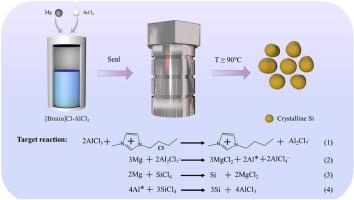室温离子液体体系中高性能锂离子电池用高结晶大硅纳米颗粒的制备
IF 7.9
2区 工程技术
Q1 CHEMISTRY, PHYSICAL
引用次数: 0
摘要
据报道,用于合成纳米硅的反应系统通常涉及高温、昂贵的设备、精心控制的惰性气氛或高活性还原剂。因此,这些因素不可避免地导致大量的能源消耗、安全风险和复杂的操作程序。本文提出了一种通过离子液体反应体系合成大尺寸高结晶纳米硅的创新方法。这种独特的室温离子液体体系有效地促进了内部动力学反应,通过改变反应温度可以合成初级粒径在63 ~ 155 nm之间的大尺寸纳米硅。值得注意的是,当用作锂离子电池的负极材料时,所得到的纳米si -200不需要碳涂层和氢氟酸蚀刻处理,表现出优异的长期循环稳定性,在0.5 a g−1下循环300次后,其容量保持率高达98.8%。此外,在2g−1下循环700次后,保留率保持在80.2%,比容量保持在1097 mA h g−1;在3g−1下循环1000次,比容量保持在962 mA h g−1。该制备体系为大尺寸纳米硅的合成提供了新的途径,并有望在各个领域激发纳米硅的发展。本文章由计算机程序翻译,如有差异,请以英文原文为准。

Preparation of highly-crystalline large silicon nanoparticles for high-performance lithium-ion batteries in room temperature ionic liquid systems
The reported reaction systems employed for the synthesis of nano-silicon typically involve high temperatures, costly apparatus, meticulously controlled inert atmospheres, or highly reactive reducing agents. As a result, these factors inevitably lead to substantial energy expenditure, safety risks, and intricate operational procedures. Herein, an innovative approach is presented for the synthesis of large-size and highly-crystalline nano-Si through an ionic liquid reaction system. This unique room temperature ionic liquid system effectively facilitates the internal kinetic reactions and synthesizes large-size nano-Si with primary particle sizes ranging from 63 to 155 nm by varying the reaction temperature. Remarkably, when employed as the anode material in lithium-ion batteries, the resulting nano-Si-200 without the need for carbon coating and hydrofluoric acid etching treatment exhibits exceptional long-term cycling stability, with a superior capacity retention rate of 98.8 % at 0.5 A g−1 after 300 cycles. Moreover, the retention rate remains at 80.2 % while maintaining a specific capacity of 1097 mA h g−1 after 700 cycles at 2 A g−1, and persistently endures for 1000 cycles at 3 A g−1 with a specific capacity of 962 mA h g−1. This preparative system provides a new avenue for the synthesis of large nano-Si and holds promise for inspiring advancements of nano-Si in various fields.
求助全文
通过发布文献求助,成功后即可免费获取论文全文。
去求助
来源期刊

Journal of Power Sources
工程技术-电化学
CiteScore
16.40
自引率
6.50%
发文量
1249
审稿时长
36 days
期刊介绍:
The Journal of Power Sources is a publication catering to researchers and technologists interested in various aspects of the science, technology, and applications of electrochemical power sources. It covers original research and reviews on primary and secondary batteries, fuel cells, supercapacitors, and photo-electrochemical cells.
Topics considered include the research, development and applications of nanomaterials and novel componentry for these devices. Examples of applications of these electrochemical power sources include:
• Portable electronics
• Electric and Hybrid Electric Vehicles
• Uninterruptible Power Supply (UPS) systems
• Storage of renewable energy
• Satellites and deep space probes
• Boats and ships, drones and aircrafts
• Wearable energy storage systems
 求助内容:
求助内容: 应助结果提醒方式:
应助结果提醒方式:


